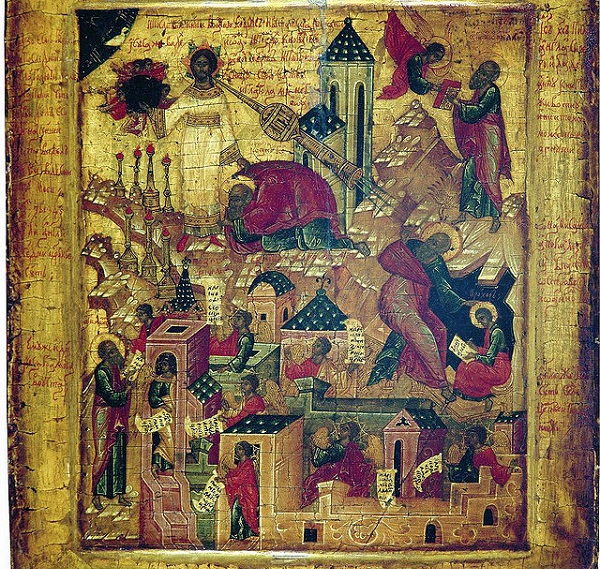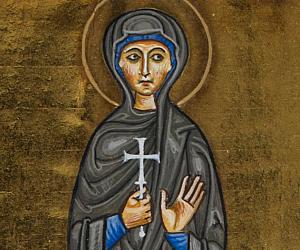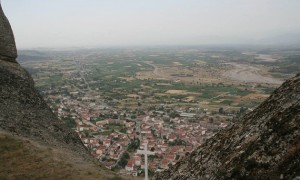The God of the New Testament in the Old Testament (part 1)
17 February 2017“The thrones were set and the Ancient of Days took His seat. His raiment was white as snow, and the hair of His head as pure wool. His throne was a flame of fire…A river of fire rushed before Him…The tribunal sat and the books were opened. And the beast was given over to the burning of the fire” (Daniel 7:9-11)
This famous vision of God in the book of Daniel has perplexed theologians and inspired artists and authors for centuries. Many Christians regard this vision of the Ancient of Days as a vision of God the Father. But contra Orthodox Christianity, this is a vision of God the Son, the eternal Word of God, the pre-incarnate Christ. “In the beginning was the Word, and the Word was with God, and the Word was God” (Jn 1:1). Christianity rests on the belief in “one Lord Jesus Christ, the Only-begotten Son of God, begotten of the Father before all ages…through Him all things were made”. Christ is Co-eternal with the Father and the Spirit. But there has always been among Christians a tendency to regard the Father as the ‘protagonist’ of the Old Testament. Even when the Son of God is understood as co-eternal with the Father, He is all too often thought of as ‘waiting in the wings’, someone of whose coming we are foretold, but remaining Himself entirely unseen. Yet the hymns of the Orthodox Church and the writings of the Eastern Fathers of the Church reveal that the Pre-incarnate Christ is in fact at the forefront of the Old Testament Scriptures.

The Christological understanding of the Ancient of Days may become clearer when we consider the appearance of the risen Christ as seen by the beloved disciple on Patmos:
“I turned around to see the voice that was speaking to me. And when I turned I saw… someone like a son of man…The hair on his head was white like wool, as white as snow, and his eyes were like blazing fire. His feet were like bronze glowing in a furnace, and his voice was like the sound of rushing waters…and coming out of his mouth was a sharp, double-edged sword. His face was like the sun shining in all its brilliance. When I saw him, I fell at his feet as though dead. Then he placed his right hand on me and said: “Do not be afraid. I am the First and the Last. I am the Living One; I was dead, and now behold, I am alive for evermore! And I hold the keys of death and Hades”. (Rev.1:l2 -18)
The risen Christ appears much like the Ancient of Days, much like Jesus appeared when He was transfigured before His Disciples on Mount Tabor (Matt.17:1-9). Christ is the Ancient of Days because He is eternal. “From everlasting to everlasting, you are God” (Psalm 89:2 [LXX]). He is older than all creation, and He has no end. Some confusion, however, has arisen regarding the identity of the Ancient of Days due to the following passage in the Book of Daniel:
“I beheld one coming with the clouds as the Son of man, and he came unto the Ancient of Days, and was brought near to Him. To him was given the dominion, and the honour, and the kingdom. His dominion is an everlasting dominion which shall not pass away”.
Since it is widely known that the Son of Man is Christ, one may be tempted to think that the Ancient of Days is the Father. But patristic teaching reveals that the Son of Man refers to the Incarnate Word, “For it is His humanity that he names son of man.” (St Athanasius the Great, Epistle to Antiochus), while the Ancient of Days is the Pre-incarnate Word. Therefore the Ancient of Days and the Son of Man are one and the same person:
“Daniel saw a type and image of what was to be in the future, that is, the invisible Son and Word of God was to become truly man so He could be united with our nature.” (St. John of Damascus, On Divine Images, 3.26).
“In the likeness of a son of man, he foresees the incarnation of the Only-begotten One.” (St. Ammonius, P.G. 85, l380A)
“Let us all raise our eyes to God in heaven, as we cry like Jeremiah: The One who appeared on earth, this is our God, who also willingly lived among men, and underwent no change, who showed himself in different shapes to the prophets, whom Ezekiel contemplated like the form of a man on the fiery chariot, and Daniel as a son of man and ancient of days proclaiming the ancient and the young to be one Lord: The One who appeared and enlightened all things”. (St Romanos the Melodist, 2nd Kontakion for the Theophany)
In many hymns and patristic homilies on the Nativity, we are invited to ponder the profound humility of the Ancient of Days coming to us in the most defenceless and vulnerable way imaginable, as a newborn baby:
“But what can I say? For the wonder astounds me. The Ancient of Days Who sits upon a high and exalted throne is laid in a manger.” (St. John Chrysostom, Homily on the Saviour’s Birth)
“The Ancient of Days became an infant.” (St. Athanasius, Homily on the Birth of Christ)
“Let the earth bow down, let every tongue sing, chant, and glorify the Child God, forty-day old and pre-eternal, the small Child and Ancient of Days, the suckling Child and Creator of the ages.” (St. Cyril of Jerusalem, Homily on the Presentation of the Lord)
“The Ancient of Days, Who of old gave the Law to Moses on Sinai, today is seen as an Infant…” (Liti of Vespers, Presentation of the Lord)
“The Ancient of Days becomes an Infant for me…”(Matins, Kathisma)
“The Ancient of Days, O all-holy One, descended in your blessed womb as rain upon the fleece, and the Lover of Man appeared as a new Adam.” (Theotokion, 5th Ode, Matins, St. Polycarp of Smyrna, Feb.23)
“You have borne incomprehensibly the Ancient of Days as a new Child Who showed us new paths of virtue upon the earth…” (Theotokion, 1st Ode of Friday Matins in the 5th tone)
“You have borne the Ancient of Days as a new Child unto us…” (Theotokion, 8th Ode of Tues. Matins in the 6th tone)
“You have surpassed the laws of nature, O pure Daughter, in bringing a new Child upon the earth Who is both the Lawgiver and the Ancient of Days…” (Theotokion, 8th Ode, Matins, 5th Sunday of Lent)
“The just Symeon received into his aged arms the Ancient of Days under the form of infancy, and, therefore, blessed God saying, “Now let your servant depart in peace…” (St. Methodius of Olympus, P.G.18, 3658)
This is one of the distinctive characteristics of Orthodox hymnology and patristic theology: the amazement at God’s humility, the juxtaposition of His almighty power and divine majesty and the profound humbleness of His humanity. The same God who sits on a throne of glory served by a myriad of angelic hosts is born in a grotty cave as a defenceless child! The one whom heaven itself cannot contain is contained in a woman’s womb! He who has no beginning is born! The God who created all things permits His creation to crucify Him! And nowhere is this wonder more explicit than in the hymns of Great Friday: “He who hung the earth upon the waters is hung upon a tree”, “He who wraps the heavens in clouds is wrapped in a purple of mockery”.
Thus only when we enter the minds of the Church Fathers and their understanding of the Old Testament can we begin to appreciate and make our own their wonder at God’s humility and love for mankind. Though able to destroy us in our iniquities, He chooses to humble Himself, to suffer and die for us! But only to rise again and to raise our human nature with Him into the heights of Heaven. For death cannot contain the Giver of Life, the Ancient of Days! “I am the First and the Last. I am the Living One; I was dead, and behold, I am alive for evermore! And I hold the keys of death and Hades” (Rev. 1:18). To Him be glory and dominion, forever and ever. Amen.











